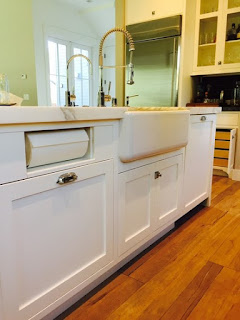Kitchen Confidential: The Case for Corbels
by Sam Ferris
Get the skinny on the
different types of
brackets and how to use them in the kitchen
brackets and how to use them in the kitchen
Corbels aren’t a new invention by any means, but the ways in
which we incorporate these structural and decorative brackets into our kitchen
designs are ever-evolving. In fact, corbels are
one of the more versatile interior design tools available. Whether used as room
dividers and countertop supports or as hard-hitting accent pieces and
delectable details, there are no slim pickings when you’re designing your
kitchen with corbels. Take a look at the full menu of options and make sure the
heart of your home doesn’t miss a beat.
Types of Corbels
Wood. Hand-carved or premade wood corbels are commonly used in kitchens. They enhance the cabinet design when they match the finish of the cabinets.
Wood. Hand-carved or premade wood corbels are commonly used in kitchens. They enhance the cabinet design when they match the finish of the cabinets.
Acanthus leaf. These corbels recall classic Greek architecture and give your
kitchen an authentic Mediterranean ambience. Needless to say, expect a
sophisticated, time-honored look when they grace the ends of your island.
Modern. These corbels don’t have the detail you see in
traditional and acanthus leaf corbels. Sleek, to-the-floor corbels can embolden
your island design and have a seamless look all at once.
Wrought iron. These corbels are dynamic. It isn’t just the fact that they’re
multipurpose pieces that provide both support and decoration. It’s also because
of how versatile their look is. They’re raw enough to add edge to an industrial
kitchen design. They have the curves and intricacies for Mediterranean and
Spanish-style spaces. And in traditional designs, they’re just the brush of
detail you need.
Where to Use Corbels
Kitchen islands. One of the main functions of corbels is to add detail. And if kitchens are the hub of the home, then islands are the hot spot for detail. Corbels are most often incorporated at the ends of the island or underneath a countertop overhang. Transform your island into a furniture-style piece by combining detailed corbels with wainscot panels and decorative legs.
This rustic eat-in kitchen has traditional wooden brackets supporting the island’s butcher block countertop. Using corbels in lieu of metal brackets is a good way to ensure that your island design stays decorative.
Kitchen islands. One of the main functions of corbels is to add detail. And if kitchens are the hub of the home, then islands are the hot spot for detail. Corbels are most often incorporated at the ends of the island or underneath a countertop overhang. Transform your island into a furniture-style piece by combining detailed corbels with wainscot panels and decorative legs.
This rustic eat-in kitchen has traditional wooden brackets supporting the island’s butcher block countertop. Using corbels in lieu of metal brackets is a good way to ensure that your island design stays decorative.
Vent hoods. If you want a standout stove area, use giant
corbels underneath your kitchen hood to create the illusion of support. This
draws attention to the design and gives it a larger-than-life presence in your
kitchen.
You don’t have to place large corbels underneath your kitchen
hood to make a statement. Smaller corbels (along with an eye-catching vintage
timepiece) can also move your kitchen hood to the limelight, as they do in this
beachy-style San Francisco kitchen.
Shelves. The more practical side to corbels is the
ability to support wall shelves. It’s how they’ve historically been used in
architecture, after all. But the traditional corbels in this creamy,
contemporary kitchen serve more than one purpose: They’re also a subtle
decorative touch that adds dimension to an otherwise minimalist design.
Room dividers. Doors and walls are traditional ways to separate
rooms, but corbels are an alternative solution for creating barriers,
especially in contemporary and modern kitchen designs. Mount corbels on the
ceiling near your kitchen’s entrance to designate a boundary between it and the
adjacent space.
Ceilings. Here wooden ceiling corbels establish barely-there boundaries in
an industrial open kitchen design.
Ceiling corbels can also
act as mood-setting pieces instead of room dividers. Large wooden bracket
corbels scale the walls in this traditional Texas kitchen, recreating a vintage
American farmhouse look.
Upper cabinets. You can also accentuate one or more of your wall cabinets by
putting corbels underneath them. Choose cabinets with glass-paned doors and
matching end panels for a vintage furniture feel.
Lower cabinets. Like wall cabinets, you can make a base cabinet pop as well. The
best way to do this is to increase the depth of one of your cabinets and put a
corbel on each side in the filler space.
As you move forward in remodeling your kitchen, let Cabinet-S-Top take care of the details and design a kitchen that will pop! The one-stop kitchen and bath showroom is located at 1977 Medina Road, Medina, OH 44256 ~ 330.239.3630 ~ www.cabinet-s-top.com

















Thanks for sharing the useful information. It was really amazing and very informative. Keep sharing
ReplyDeleteGreen Kitchen Cabinets
Design A Kitchen Remodel
Country Kitchen Cabinets
Bathroom Remodel
Flooring Installation